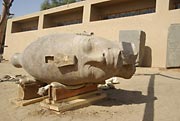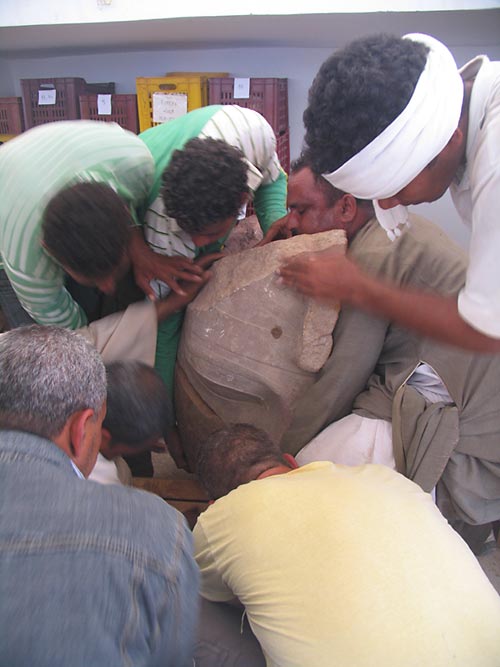
|
HiddenMysteries.com HiddenMysteries.net HiddenMysteries.org |
* * * * * * * * * * * * * * * * * * * * * * * * * * * * * * * * * * * * * * *
A word from our sponsor

Momentous new finds
Saturday, March 06 2010 @ 07:58 PM CST
Increase font Decrease font
This option not available all articles
A colossal head of Tutankhamun's grandfather in Luxor and the burial chamber of Queen Behenu of the Sixth Dynasty in Saqqara are the latest antiquities discovered in Egypt, reports Nevine El-Aref

The granite head of King Amenhotep III
Less than two weeks after proof was obtained of the lineage of the golden king Tutankhamun, a multi-national team of archaeologists has unearthed a colossal red granite head of Tutankhamun's grandfather Pharaoh Amenhotep III during routine excavations in the Pharaoh's mortuary temple at Kom Al-Hettan on Luxor's west bank.
When constructed, the temple covered an area of 350,000 square metres and was the largest mortuary temple in the Theban necropolis. Today it has almost totally disappeared except for those two massive stone statues known as the Colossi of Memnon, which each represent the seated Amenhotep and stand at 18 metres high. Both statues once stood at the gateway of the temple, which was constructed closer to the river than any of the other mortuary temples, and hence decayed more quickly in the soft mud. Its proximity to habitation meant its stones were plundered for local building. A granite stelae of Amenhotep III is visible in the temple of Merenptah, which is located about 100 metres to the north.
In 1998 the temple was listed by the World Monuments Watch as one of the world's 100 most endangered monuments.
The newly-discovered head, carved in red granite, portrays Amenhotep as a fine, youthful man with sculptured features. It is smoothly polished and perfectly preserved with some traces of red paint on the hood of the ureaus (cobra). "It is a masterpiece of highly artistic quality," Zahi Hawass, secretary-general of the Supreme Council of Antiquities (SCA), told Al-Ahram Weekly.
Hourig Sourouzian, the head of the mission, said that the king was wearing the Upper Egyptian white crown but his ceremonial beard was broken under the chin. "I believe that it may still lie under the rubble below the level where the head was discovered," Sourouzian suggested. She continued that the head belonged to a large statue representing the king standing, with hands holding the royal insignia and crossed on the chest.
In recent years the mission has gathered a large quantity of pieces of a red granite statue, which once stood in the southern part of the great court of the funerary temple of Amenhotep III. Parts of the body of the statue are currently in restoration. More than 84 colossal statues have been unearthed inside it. Among them are those of Pharaoh Amenhotep III and his wife Queen Tiye, whose mummy was identified on 17 February by Hawass and a team of scientists.
in the Saqqara necropolis, the French mission has stumbled upon the burial chamber of Queen Behenu who was most probably the wife of the Sixth-Dynasty king Pepi II, although studies have not yet confirmed if she was the wife of Pepi I or Pepi II. Hawass said the discovery was made during the cleaning of Behenu's pyramid on the western side of King Pepi I's pyramid in Al-Shawaf, south Saqqara. The burial chamber is badly destroyed except for two of the inner walls on which are engraved pyramid texts. Such pyramid texts were widely used during the fifth and sixth dynasties.
Philippe Collombert, head of the team in Saqqara, said that further excavation inside the burial chamber led them to the queen's granite sarcophagus, which is engraved with the queen's titles but tells nothing of the identity of her husband.
The French mission which has worked on Pepi I's necropolis since 2007 has previously discovered the 25-metre tall pyramid of Behenu, as well as several fragments of the pyramid text.
Pyramid texts were discovered for the first time inside the burial chamber of the last king of the Fifth Dynasty, king Unas, in his pyramid in Saqqara. They were later found in kings' and queens; pyramids belonging to the Sixth Dynasty.
The pyramid texts are religious passages containing spells that are primarily concerned with protecting the Pharaoh's remains, reanimating his body after death, and helping him ascend to the heavens -- all essential components of the afterlife. The spells delineate all the ways the Pharaoh could travel, including the use of ramps, stairs, ladders, and most importantly flying. The spells could also be used to call on the gods for help, and even threatening them if they did not comply.
From 1989 up to the present day the French mission has found seven pyramids belonging to queens in the reigns of Pepi I and Pepi II. These pyramids were those of queens Inenek, Nub- Unt, Merit-It-EsII, Ankh-Es-Pepi III, Mi-Ha and another pyramid of an unidentified queen.
ahram.org.eg

Workers at Kom Al-Hettan area on Luxor's west bank removing the newly discovered granite head of Tutankhamun's grandfather, King Amenhotep III, for restoration
Comments (0)
* * * * * * * * * * * * * * * * * * * * * * * * * * * * * * * * * * * * * * *
A word from our sponsor

HiddenMysteries
Main Headlines Page
Main Article Page
Momentous new finds
http://www.hiddenmysteries.net/newz/article.php/20100306195857902
Check out these other Fine TGS sites
HiddenMysteries.com
HiddenMysteries.net
HiddenMysteries.org
RadioFreeTexas.org
TexasNationalPress.com
TGSPublishing.com
ReptilianAgenda.com
NationofTexas.com
Texas Nationalist Movement